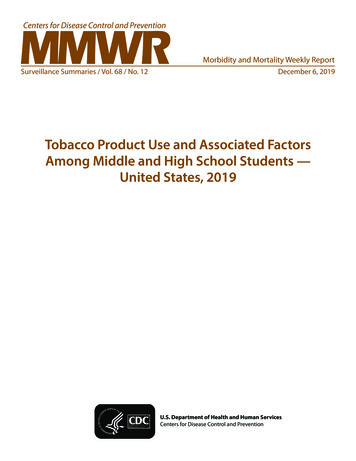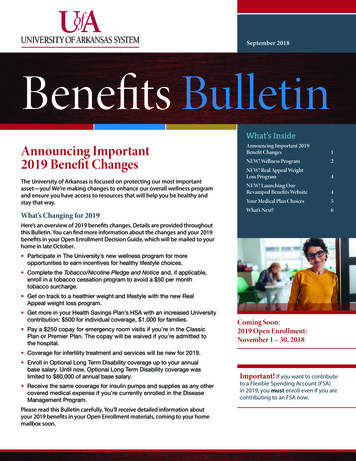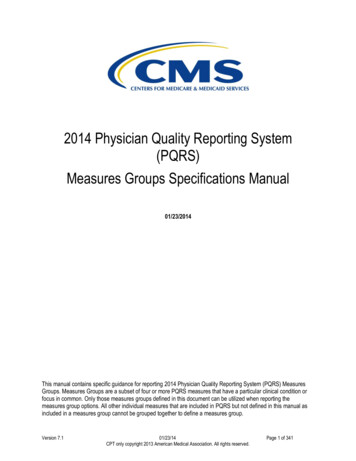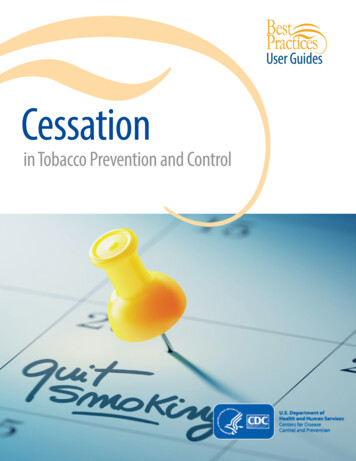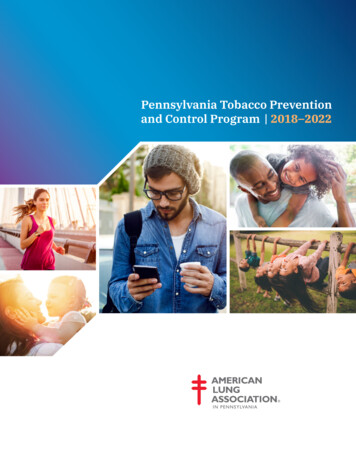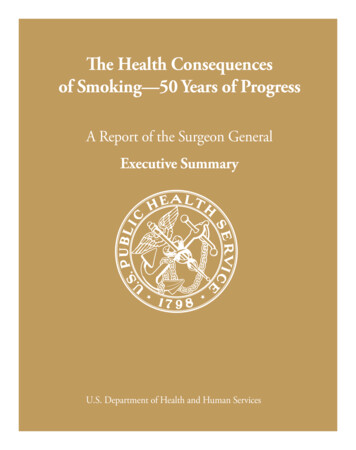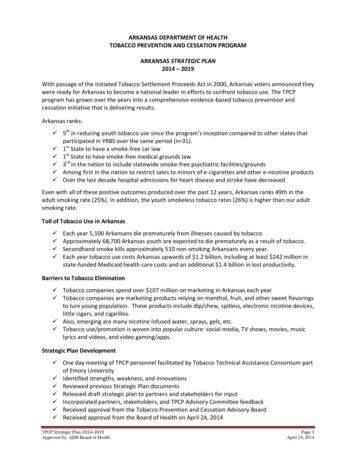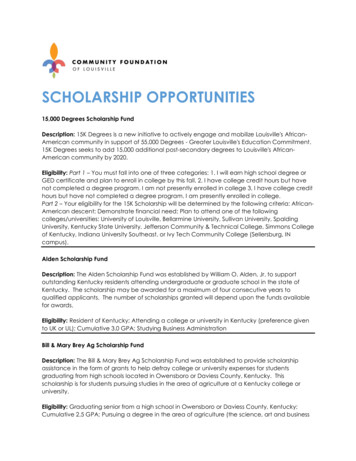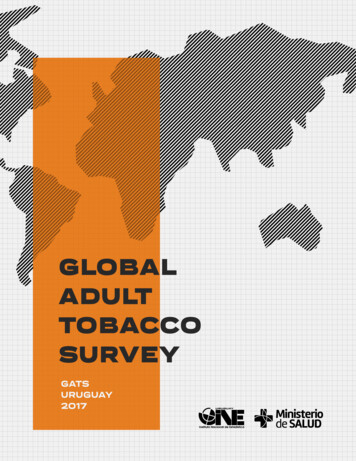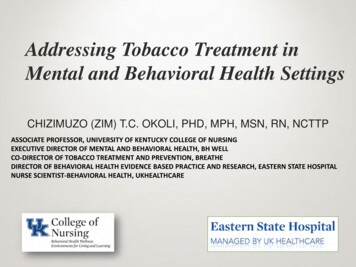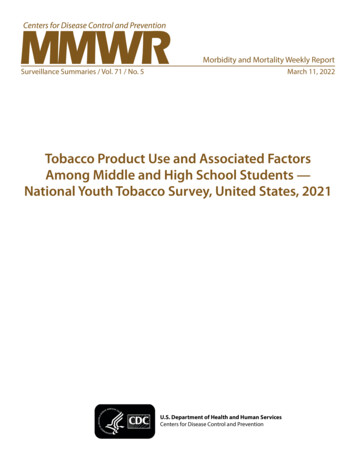
Transcription
Morbidity and Mortality Weekly ReportSurveillance Summaries / Vol. 71 / No. 5March 11, 2022Tobacco Product Use and Associated FactorsAmong Middle and High School Students —National Youth Tobacco Survey, United States, 2021U.S. Department of Health and Human ServicesCenters for Disease Control and Prevention
Surveillance iscussion. 11Limitations. 13Conclusion. 13References. 14The MMWR series of publications is published by the Center for Surveillance, Epidemiology, and Laboratory Services, Centers for Disease Control and Prevention (CDC),U.S. Department of Health and Human Services, Atlanta, GA 30329-4027.Suggested citation: [Author names; first three, then et al., if more than six.] [Title]. MMWR Surveill Summ 2022;71(No. SS-#):[inclusive page numbers].Centers for Disease Control and PreventionRochelle P. Walensky, MD, MPH, DirectorDebra Houry, MD, MPH, Acting Principal Deputy DirectorDaniel B. Jernigan, MD, MPH, Deputy Director for Public Health Science and SurveillanceRebecca Bunnell, PhD, MEd, Director, Office of ScienceJennifer Layden, MD, PhD, Deputy Director, Office of ScienceLeslie Dauphin, PhD, Director, Center for Surveillance, Epidemiology, and Laboratory ServicesMMWR Editorial and Production Staff (Serials)Charlotte K. Kent, PhD, MPH, Editor in ChiefChristine G. Casey, MD, EditorMary Dott, MD, MPH, Online EditorTerisa F. Rutledge, Managing EditorDavid C. Johnson, Lead Technical Writer-EditorJeffrey D. Sokolow, MA, Project EditorMartha F. Boyd, Lead Visual Information SpecialistAlexander J. Gottardy, Maureen A. Leahy,Julia C. Martinroe, Stephen R. Spriggs,Tong Yang,Visual Information SpecialistsQuang M. Doan, MBA, Phyllis H. King,Terraye M. Starr, Moua Yang,Information Technology SpecialistsIan Branam, MA,Acting Lead Health Communication SpecialistShelton Bartley, MPH, Leslie Hamlin,Lowery Johnson, Amanda Ray,Health Communication SpecialistsWill Yang, MA,Visual Information SpecialistMMWR Editorial BoardMatthew L. Boulton, MD, MPHCarolyn Brooks, ScD, MAJay C. Butler, MDVirginia A. Caine, MDJonathan E. Fielding, MD, MPH, MBADavid W. Fleming, MDTimothy F. Jones, MD, ChairmanWilliam E. Halperin, MD, DrPH, MPHJewel Mullen, MD, MPH, MPAJeff Niederdeppe, PhDCeleste Philip, MD, MPHPatricia Quinlisk, MD, MPHPatrick L. Remington, MD, MPHCarlos Roig, MS, MAWilliam Schaffner, MDNathaniel Smith, MD, MPHMorgan Bobb Swanson, BSAbbigail Tumpey, MPH
Surveillance SummariesTobacco Product Use and Associated Factors Among Middle andHigh School Students — National Youth Tobacco Survey,United States, 2021Andrea S. Gentzke, PhD1; Teresa W. Wang, PhD1; Monica Cornelius, PhD1; Eunice Park-Lee, PhD2; Chunfeng Ren, PhD2; Michael D. Sawdey, PhD2;Karen A. Cullen, PhD2; Caitlin Loretan, MPH 1; Ahmed Jamal, MBBS1; David M. Homa, PhD11Officeon Smoking and Health, National Center for Chronic Disease Prevention and Health Promotion, CDC; 2Center for Tobacco Products,Food and Drug AdministrationAbstractProblem/Condition: Commercial tobacco use is the leading cause of preventable disease, disability, and death in the United States.Most tobacco product use begins during adolescence. In recent years, tobacco products have evolved to include various combusted,smokeless, and electronic products.Period Covered: 2021.Description of System: The National Youth Tobacco Survey (NYTS) is an annual, cross-sectional, school-based, self-administeredsurvey of U.S. middle school (grades 6–8) and high school (grades 9–12) students. A three-stage cluster sampling procedureis used to generate a nationally representative sample of U.S. students attending public and private schools. NYTS is the onlynationally representative survey of U.S. middle and high school students that focuses exclusively on tobacco use patterns andassociated factors. NYTS provides data to support the design, implementation, and evaluation of comprehensive youth tobacco useprevention and control programs and to guide tobacco regulatory activities. Since 2019, NYTS has been administered electronicallyvia tablet computers. Because of emergency COVID-19 protocols that were in place across the United States during the 2021NYTS fielding window (January 18–May 21, 2021), the 2021 survey was administered using a web URL to allow participationby eligible students learning under varying instructional models (in-person, distance/virtual, and hybrid). In total, 50.8% ofstudent respondents reported completing the survey in a school building or classroom and 49.2% at home or some other place.CDC and the Food and Drug Administration (FDA) analyzed data from the 2021 NYTS to assess tobacco product use patternsand associated factors among U.S. middle and high school students. Overall, 20,413 students (out of 25,149 sampled students;student response rate: 81.2%) completed the questionnaire from 279 schools (out of 508 sampled schools; school response rate:54.9%). The overall response rate, defined as the product of the student and school response rates, was 44.6%. The sample wasweighted to represent approximately 11.97 million middle school students and 15.44 million high school students. Students withmissing information about grade level were excluded from the school-level analyses (n 135).Results: In 2021, an estimated 34.0% of high school students (5.22 million) and 11.3% of middle school students (1.34 million)reported ever using a tobacco product (i.e., electronic cigarettes [e-cigarettes], cigarettes, cigars, smokeless tobacco, hookahs, pipetobacco, heated tobacco products, nicotine pouches, and bidis [small brown cigarettes wrapped in a leaf ]). Current (past 30-day)use of a tobacco product was 13.4% for high school students (2.06 million) and 4.0% for middle school students (470,000).E-cigarettes were the most commonly currently used tobacco product, cited by 11.3% of high school students (1.72 million)and 2.8% of middle school students (320,000), followed by cigarettes, cigars, smokeless tobacco, hookahs, nicotine pouches,heated tobacco products, and pipe tobacco. Current use of any tobacco product was reported by 14.2% of students identifying aslesbian, gay, or bisexual (LGB) (versus 7.9% of heterosexual); 18.9% of students identifying as transgender (versus 8.2% of nottransgender); and 14.2% of students reporting severe psychological distress (versus 5.5% with no distress). Among students whocurrently used each respective tobacco product, frequent use (on 20 days of the past 30 days) ranged from 17.2% for nicotinepouches to 39.4% for e-cigarettes. Among current users of any tobacco product, 79.1% reported using a flavored tobacco product;by product, e-cigarettes were the most commonly used flavored tobacco product. Among current users of any tobacco product,the most commonly reported source of access was from a friend(32.8%). Among students who currently used e-cigarettes,53.7% used a disposable device, 28.7% used a prefilled/refillableCorresponding author: Andrea Gentzke, PhD, National Center forpod or cartridge device, 9.0% used a tank or mod systemChronic Disease Prevention and Health Promotion, CDC. Telephone:404-498-1795; E-mail: msv3@CDC.gov.(a system that can be customized by the user), and 8.6% didUS Department of Health and Human Services/Centers for Disease Control and PreventionMMWR / March 11, 2022 / Vol. 71 / No. 51
Surveillance Summariesnot know the device type. Among students who had ever used e-cigarettes, the most common reason for first trying them was “afriend used them” (57.8%); among current e-cigarette users, the most commonly cited reason for current use was “I am feelinganxious, stressed, or depressed” (43.4%). Among all middle and high school students, 75.2% reported past-year recognition ofany antitobacco public education campaign ads. Exposure to marketing or advertising for any tobacco product was reported by75.7% of students who had contact with an assessed potential source of tobacco product advertisements or promotions (going to aconvenience store, supermarket, or gas station; using the Internet; watching television or streaming services or going to the movies;or reading newspapers or magazines). Among students who reported using social media, 73.5% had ever seen e-cigarette–relatedcontent. Among all students, perceiving “no” or “little” harm from intermittent tobacco product use was highest for e-cigarettes(16.6%) and lowest for cigarettes (9.6%). Among students who currently used any tobacco product, 27.2% had experiencedcravings during the past 30 days; 19.5% reported wanting to use a tobacco product within 30 minutes of waking. Moreover,65.3% of students who currently used tobacco products were seriously thinking about quitting the use of all products, and 60.2%had stopped using all products for 1 day because they were trying to quit during the past 12 months.Interpretation: In 2021, approximately one in 10 U.S. middle and high school students (9.3%) had used a tobacco product duringthe preceding 30 days. By school level, this represented more than one in eight high school students (13.4%) and approximatelyone in 25 middle school students (4.0%). E-cigarettes were the most commonly used tobacco product in 2021. Tobacco productuse was higher among certain subpopulations, such as those identifying as LGB or transgender, or those reporting psychologicaldistress. Importantly, approximately two thirds of students who currently used tobacco products were seriously thinking aboutquitting. However, factors that might continue to promote tobacco product use among U.S. youths, such as the availability offlavors, access to tobacco products, exposure to tobacco product marketing, and misperceptions about harm from tobacco productuse, remained prevalent in 2021.Public Health Action: The continued monitoring of all forms of youth tobacco product use and associated factors throughsurveillance efforts including NYTS is important to the development of public health policy and action at national, state, and locallevels. The 2021 NYTS was successfully administered during the COVID-19 pandemic using a web URL to allow participationby eligible students learning under varying instructional models. As a result of these modifications to the fielding procedures,any comparison of results between 2021 NYTS findings with previous years, including the direct attribution of any potentialchanges in tobacco product use, is not possible. Parents, educators, youth advocates, and health care providers can help protectyouths from the harms of tobacco products, including e-cigarettes. In addition, the comprehensive and sustained implementationof evidence-based tobacco control strategies, combined with FDA’s regulation of tobacco products, is important for reducing allforms of tobacco product use among U.S. youths.IntroductionTobacco* product use is the leading cause of preventabledisease, disability, and death in the United States (1).Preventing tobacco product use among youths is critical todecreasing morbidity and mortality because almost all tobaccoproduct use begins during adolescence or young adulthood;approximately nine in 10 adults who smoke cigarettes startedbefore age 18 years (1–3). In recent years, tobacco productshave evolved to include various combusted, smokeless, andelectronic products.The National Youth Tobacco Survey (NYTS), conductedperiodically during 1999–2009 and annually since 2011,provides national data on estimates of tobacco product use* The term “tobacco” as used in this report refers to commercial tobacco productsand not to sacred and traditional use of tobacco by some American Indiancommunities.2MMWR / March 11, 2022 / Vol. 71 / No. 5to support the design, implementation, and evaluation ofcomprehensive youth tobacco prevention and control programsand to inform tobacco regulatory activities in the United States(4). NYTS is the only nationally representative survey of U.S.middle (grades 6–8) and high school (grades 9–12) studentsthat focuses exclusively on tobacco product use.This report presents findings from the 2021 NYTS anddescribes the prevalence of youth tobacco product use andassociated factors, including flavored tobacco product use,reasons for use, access to tobacco products, exposure to protobacco and antitobacco product marketing, harm perceptions,urges to use tobacco products, and quitting behaviors. Thesefindings can be used by public health professionals, health careproviders, policymakers, parents, and other youth advocates toprevent and reduce tobacco product use among U.S. youths.US Department of Health and Human Services/Centers for Disease Control and Prevention
Surveillance SummariesMethodsNYTS Sampling ProceduresNYTS is a cross-sectional, school-based, self-administeredsurvey of U.S. middle and high school students (4). The 2021NYTS sampling frame consisted of all regular public andprivate schools with students enrolled in grades 6–12 in the50 U.S. states and the District of Columbia. The samplingframe comprised data obtained from Market Data Retrieval(5) and the National Center for Education Statistics (6,7).Alternative schools, special education schools, U.S. Departmentof Defense–operated schools, Bureau of Indian Affairs schools,vocational schools, and schools with a combined total of 40 students in grades 6–12 were excluded. Across 16 previouscycles of NYTS, school participation had averaged 80.8%with a low of 49.9%. Student participation had averaged89.5% with a low of 85.9%. Historical participation rates atboth school and student levels guided the sampling designand projected sample sizes. However, a more robust approachwas used to calculate the projected sample sizes for the 2021NYTS by assuming a more conservative overall response rate of42.5%. The overall number of schools included in the samplewas increased to account for higher levels of anticipated schoolrefusals attributable to COVID-19 precautions. NYTS usesa stratified, three-stage cluster sample design (4). All studentsin the selected classes were eligible to participate in the survey;students who were unable to complete the questionnairewithout special assistance were excluded.Data Collection and ProcessingBecause of emergency COVID-19 protocols across theUnited States, the 2021 NYTS was conducted using anonline survey to allow eligible students to participate whileat school or at home during a designated class period as partof a class activity.† Participation in NYTS was voluntary atboth the school and student levels; parental consent andstudent assent were required for NYTS participation. Studentslogged into a secure website from a school-issued or personalInternet-connected device, watched an instructional video,and responded to a question regarding their current location(e.g., classroom, home, or other location) before completing† In2019, NYTS transitioned from a paper and pencil questionnaire to anelectronic survey. The 2019 and 2020 NYTS were conducted offline usingprovided tablet computers in schools; data collection was supported by trainedsurvey administrators (4). This methodology was not feasible for the 2021NYTS because of the implementation of emergency COVID-19 protocols acrossthe country, including various school instructional models (in-person, distance/virtual, and hybrid), restricted visitor access at schools, travel restrictions, andother factors.the survey. Data were transmitted directly to a secure server.Data collection procedures were supported by trained, off-sitetechnical assistance providers who maintained regular contactwith selected schools and teachers before, during, and afterdata collection activities. Students or whole classes that wereunable to participate during the primary data collection periodwere asked to take the survey at the next possible opportunity.The 2021 NYTS was reviewed and approved by the Officeof Management and Budget, the contracted data collectors’institutional review board (IRB), and CDC’s IRB.§The 2021 survey included 166 questions coveringdemographic information, tobacco product use behaviors,knowledge of and attitudes toward tobacco use, exposure toprotobacco and antitobacco media and advertising, access totobacco products, nicotine dependence, cessation attempts,exposure to secondhand smoke and e-cigarette aerosol, harmperceptions, exposure to tobacco product health warnings, andother tobacco-related topics. At the beginning of each tobaccoproduct section, a description of the product, includingexample brands and generic images, was provided. Respondentsdid not answer all questions because of questionnaire skippatterns. Respondents could skip any question or end thesurvey at any time.Survey administration occurred during January 18, 2021–May 21, 2021. The final sample consisted of 508 schools,of which 279 participated (school response rate: 54.9%);20,413 student questionnaires were completed out of asample of 25,149 students (student response rate: 81.2%).Student response rates varied by school instructional model;student response rates were 85.8% among schools within-person instruction (n 69 participating schools), 77.9% inschools with exclusive distance learning or virtual instruction(n 68 participating schools), and 81.4% for schools withhybrid instruction (n 142 participating schools). Hybridstudent instructional models define instances in which someeducational instruction happened in person and some happenedvirtually. This included various scenarios, including all studentsalternating between in-person and virtual learning or a portionof students receiving in-person instruction at all times and theremaining students receiving virtual instruction at all times. Theoverall response rate for the 2021 NYTS, defined as the productof the school-level and student-level response rates, was 44.6%.After exclusion of outliers, the average survey completion timewas approximately 22 minutes. A weighting factor was appliedto each student record to adjust for nonresponse and for varyingprobabilities of selection. Weights were adjusted to ensure thatthe weighted proportions of students in each grade matched§ 45US Department of Health and Human Services/Centers for Disease Control and PreventionC.F.R. part 46; 21 C.F.R. part 56.MMWR / March 11, 2022 / Vol. 71 / No. 53
Surveillance Summariesnational population proportions. Additional informationon the NYTS sampling design, recruitment procedures, anddata weighting is available (https://www.cdc.gov/tobacco/data statistics/surveys/nyts/index.htm).MeasuresEver and Current Tobacco Product UseNine tobacco products were assessed: electronic cigarettes(e-cigarettes), cigarettes, cigars (cigars, cigarillos, and littlecigars), smokeless tobacco (chewing tobacco, snuff, dip, snus,and dissolvable tobacco products), hookahs, pipe tobacco, bidis(small brown cigarettes wrapped in a leaf ), heated tobaccoproducts (HTPs), and nicotine pouches (pouches containingnicotine powder that comes from tobacco, which users placein their mouth). For each product, ever use was defined asever using the product, and current use was defined as use on 1 day during the past 30 days. Any tobacco product use wasdefined as use of one or more of the nine tobacco products.Use of two or more tobacco products was defined as use oftwo or more of the nine tobacco products. Any combustibletobacco product use was defined as use of one or more of thefollowing: cigarettes, cigars, hookahs, pipe tobacco, and bidis.Demographic FactorsDemographic covariates assessed included sex (female ormale), race and ethnicity (non-Hispanic White, non-HispanicBlack, Hispanic, or non-Hispanic other race), sexual identity(heterosexual; lesbian, gay, or bisexual [LGB]; or not sure), andwhether the respondent identified as transgender (no, yes, notsure, or don’t know what this question is asking).Social Determinant IndicatorsSocial determinant indicators included academic status inschool (mostly As, Bs, Cs, Ds, or Fs), and speaking a languageother than English at home (yes or no). Additionally, acomposite scale made up of four questions was used to assesspsychological distress: “During the past two weeks, how oftenhave you been bothered by any of the following problems?”1) “little interest or pleasure in doing things”; 2) “feeling down,depressed, or hopeless”; 3) “feeling nervous, anxious, or onedge”; and 4) “not being able or stop or control worrying.”For each item, response options were numerically coded (notat all 0; several days 1; more than half of the days 2;nearly every day 3), summed (range: 0–12), and categorizedas none (0–2), mild (3–5), moderate (6–8), or severe (9–12).Furthermore, a composite scale made up of four questions wasused to assess family affluence. Numeric values were assignedto question responses as follows: 1) “Does your family own avehicle (such as a car, van, or truck)?” [no 0; yes, one 1;4MMWR / March 11, 2022 / Vol. 71 / No. 5yes, two or more 2]; 2) “Do you have your own bedroom?”[no 0; yes 1]; 3) “How many computers (including laptopsand tablets, not including game consoles and smartphones)does your family own?” [none 0; one 1; two 2; morethan two 3]; and 4) “During the past 12 months, how manytimes did you travel on vacation with your family?” [not atall 0; once 1; twice 2; more than twice 3]. Responseswere summed (range: 0–9) and categorized into approximatetertiles based on the weighted distribution of scores in thissample as low (0–5), medium (6–7), and high (8–9).Frequency of Tobacco Product UseRespondents who reported ever use of any tobacco productwere asked, “During the past 30 days, on how many days didyou [use e-cigarettes; smoke cigarettes; smoke cigars, cigarillos,or little cigars; use chewing tobacco, snuff, or dip; use snus;use dissolvable tobacco products; smoke tobacco in a hookahor water pipe; smoke pipes filled with tobacco; use an HTP;or use a nicotine pouch].” Response options ranged between0 and 30 days. Response options were categorized as 1–5 days,6–19 days, and 20–30 days. Frequent use was defined as usinga product on 20 days of the past 30 days.Flavored Tobacco Product UseFor each tobacco product (excluding cigarettes), currentusers were asked, “Were any of the [tobacco product] thatyou used in the past 30 days flavored to taste like menthol,mint, clove or spice, alcoholic drinks, candy, fruit, chocolate,or any other flavor?” Response options were “yes,” “no,” and“don’t know.” Those who responded “yes” were categorizedas a current flavored product user. Current flavored tobaccoproduct users were asked, “What flavors were the [tobaccoproduct] that you have used in the past 30 days? (Select oneor more).” Response options were “menthol,” “mint,” “cloveor spice,” “fruit,” “chocolate,” “alcoholic drinks (such as wine,margarita, or other cocktails),” “candy, desserts, or othersweets,” and “some other flavor not listed here.” Those whoselected “some other flavor not listed here” could provide awrite-in response; write-in responses corresponding to anoriginal response option were recoded.For cigarettes, current users were categorized as flavored(menthol) cigarette smokers if they responded “yes” to thequestion, “Menthol cigarettes are cigarettes that taste like mint.During the past 30 days, were the cigarettes that you usuallysmoked menthol?” or if they indicated “Kool” or “Newport”as their usual cigarette brand during the past 30 days. Usualcigarette brand was determined based on responses to twoquestions: “During the past 30 days, what brands of cigarettesdid you smoke? (Select one or more)” and “During the past30 days, what brand of cigarettes did you usually smoke?US Department of Health and Human Services/Centers for Disease Control and Prevention
Surveillance Summaries(Choose only one answer).” If “Kool” or “Newport” was theonly brand selected for the first question, or if multiple brandswere selected in the first question and “Kool” or “Newport”was selected for the second question, “Kool” or “Newport”was considered the respondent’s usual brand.E-Cigarette Device TypeRespondents who reported current use of e-cigarettes wereasked, “Which of the following best describes the type ofe-cigarette you have used in the past 30 days? If you have usedmore than one type, please think about the one you use mostoften.” Response options were “A disposable e-cigarette (forexample, Puff Bar or Stig),” “An e-cigarette that uses pre-filledor refillable pods or cartridges (for example, Juul, Smok, orSuorin),” “An e-cigarette with a tank that you refill with liquids(including mod systems that can be customized by the user),”and “I don’t know the type.”Reasons for E-Cigarette UseRespondents who had ever used e-cigarettes were asked,“Why did you first use an e-cigarette?” Respondents whoreported current e-cigarette use were further asked, “Why doyou currently use e-cigarettes?” For both questions, respondentscould select one or more of 14 specified reasons. Respondentswho indicated, “I used/use them for some other reasons” toeither question could specify a write-in response; analyses ofwrite-in responses were not included in this report.Access to Tobacco ProductsFor each tobacco product, access sources were assessed bytwo questions: “During the past 30 days, how did you get your[tobacco product]?” (respondents could select one or more ofeight specified responses) and “During the past 30 days, wheredid you buy your [tobacco product]?” (respondents could selectone or more of 12 specified responses). Respondents couldspecify a write-in response; analyses of write-in responses werenot included in this report.Recognition of Public Education CampaignsAgainst Tobacco Product UseAll respondents were asked two questions regarding publiceducation campaigns against tobacco product use: “In thepast 12 months, have you seen or heard The Real Cost, ontelevision, the Internet, social media, or radio as part of adsabout tobacco?” (response options were yes, no, or not sure)and “In the past 12 months, have you seen or heard any otherads against tobacco with the following names or sloganson television, the Internet, social media, or on the radio?”Respondents could select one or more of “Truth,” “Tips orTips from Former Smokers,” “Fresh Empire,” “This Free Life,”or “some other ad” or could select “I haven’t seen or heard anyof these ads.” Those who indicated having seen “some otherad” could specify with a write-in response; analyses of write-inresponses were not included in this report. A composite ofhaving recognized at least one ad against tobacco product usefrom a specified response option also was generated.Exposure to Tobacco Product MarketingExposure to tobacco product marketing (advertisementsor promotions) was assessed separately for e-cigarettes andcigarettes or other tobacco products for four sources: retailstores; Internet; television, streaming services, or movies; andnewspapers or magazines. Respondents were asked, “Whenyou [are using the Internet; read newspapers or magazines;go to a convenience store, supermarket, or gas station; watchtelevision or streaming services (such as Netflix, Hulu, orAmazon Prime), or go to the movies], how often do you seeads or promotions for [e-cigarettes; cigarettes or other tobaccoproducts]?” Respondents were categorized as exposed if theyresponded “sometimes,” “most of the time,” or “always” orunexposed if they responded “never” or “rarely.” Those whoreported “I do not use the Internet,” “I do not read newspapersor magazines,” “I never go to a convenience stores, supermarket,or gas station,” or “I do not watch TV or streaming services orgo to the movies” were excluded from the analysis.E-Cigarette Content on Social MediaAll respondents were asked, “How often do you use socialmedia?” Respondents who reported a response other than“never/I don’t use social media” were asked, “When youuse social media, how often 1) “do you see posts or content(pictures, videos, or text) related to e-cigarettes?”; 2) “doyou post pictures or videos of yourself or someone elseusing e-cigarettes?”; and 3) “have you liked, commented, orshared posts or content (pictures, videos, or text) related toe-cigarettes?” For each question, response options were “never,”“less than monthly,” “monthly,” “weekly,” or “daily.”Harm PerceptionsThe 2021 NYTS assessed harm perceptions for five tobaccoproducts: e-cigarettes; cigarettes; cigars, cigarillos, or littlecigars; smokeless tobacco (chewing tobacco, snuff, dip, snus,or dissolvable tobacco products); and hookahs. All respondentswere asked, “How much do you think people harm themselveswhen they (use e-cigarettes; smoke cigarettes; smoke cigars,cigarillos, or little cigars; use chewing tobacco, snuff, dip,snus, or dissolvable tobacco products; or smoke tobacco in ahookah or water pipe) some days but not every day?” Responseoptions were “no harm,” “little harm,” “some harm,” and “alot of harm.”US Department of Health and Human Services/Centers for Disease Control and PreventionMMWR / March 11, 2022 / Vol. 71 / No. 55
Surveillance SummariesResultsDependence and Cessation IndicatorsUrges to Use Tobacco ProductsStudents who currently used any tobacco product wereasked, “During the past 30 days, have you
NYTS is the only nationally representative survey of U.S. middle and high school students that focuses exclusively on tobacco use patterns and associated factors. NYTS provides data to support the design, implementation, and evaluation of comprehensive youth tobacco use prevention and control programs and to guide tobacco regulatory activities.
